
Visiting my uncle's country
08 October 2022 17:50Syria is the country where Father Frans van der Lugt, my uncle, was one with the Syrians and the country where life continues after the war. Just not the 'normal' life, because the people in Syria have it harder than ever. People often have only one hour of electricity per day when they do not have solar panels themselves and that is a lot, because 90% of the people live below the poverty line. The minimum wage is on average 30 euros per month and that is spent on rice and some vegetables in a family of four within four days. Other costs such as health care and education cannot be paid. Gasoline is also very expensive, so going to school or work by bus is not possible for many people. And then there is always fear that the war will flare up again. It is almost a hopeless situation where we can hopefully give these people a small bright spot on their horizon with Walk for Homs. Because this bright spot is so incredibly important, I would like to show everyone what has happened and what will happen with the donations. That is why I arranged a visa through the Jesuit Mourad, the superior of the Jesuits in Syria, one of my contact persons in Syria. But not for me alone, because I am taking my father to visit the grave of his brother Frans and a number of special destinations. Roderick, my husband, will also accompany me to experience this journey together and to visit the projects we support.

Upon arrival at Schiphol, we pass a huge line of travelers who have already checked in and are waiting to go through customs. I have to admit that this makes me quite anxious, despite the fact that we are present four hours in advance. Fortunately, when checking in, it turns out that this line is for domestic flights. It still takes us three hours to get through customs, but we arrive at the gate just in time. In Lebanon we are questioned at customs with questions such as where we are staying in the country. After we have indicated that we are going to Syria, I see the customs officer swallow and look at us. He asks how we plan to get there. When I indicate that we are going with a friend's car, it does not take long before the stamps are in our passports. Not much later we are with Mourad in his car on the way to the border of Syria.
It is already dark, but the smells and what we see give me a familiar feeling. Before we reach the border post Mourad offers us a drink in a roadhouse and a Manaousheh, a Lebanese flatbread with cheese. Through a dark valley we reach the control and border posts. I must confess that the videos on YouTube make it all more exciting than it is. At the Syrian border it is a bit confusing with getting stamps and paying a visa, but fortunately it does not take long. We are also approached by a Syrian couple living in Gouda in the Netherlands. They were on a plane with us and think it's very special to see us here, especially when they hear our story. He has been living in the Netherlands for over 6 years and his wife has also been living for 6 months. She already speaks Dutch very well and because of his residence permit he can finally visit the family they had to leave behind. When we have passed the last checkpoint we cheer, because we are finally in Syria!
After a journey of 14.5 hours we arrived in Damascus. Staying here in the Jesuit Residence where we have a drink after admiring Frans' old room and then go to bed. The next day there is a full program waiting for us.
Day 2: Damascus, Jaramanah, Maaloula and Deir Mar Moussa

After breakfast with the other Jesuits staying in the house, Mourad takes us to the old town of Damascus. Crossing the road is a challenge, because there is only electricity for one hour a day and because of that the traffic lights don't work. In addition, everyone drives and walks across the road, so we follow Mourad on his heels.
Al-Hamidiyah Souq and Umayyad mosque
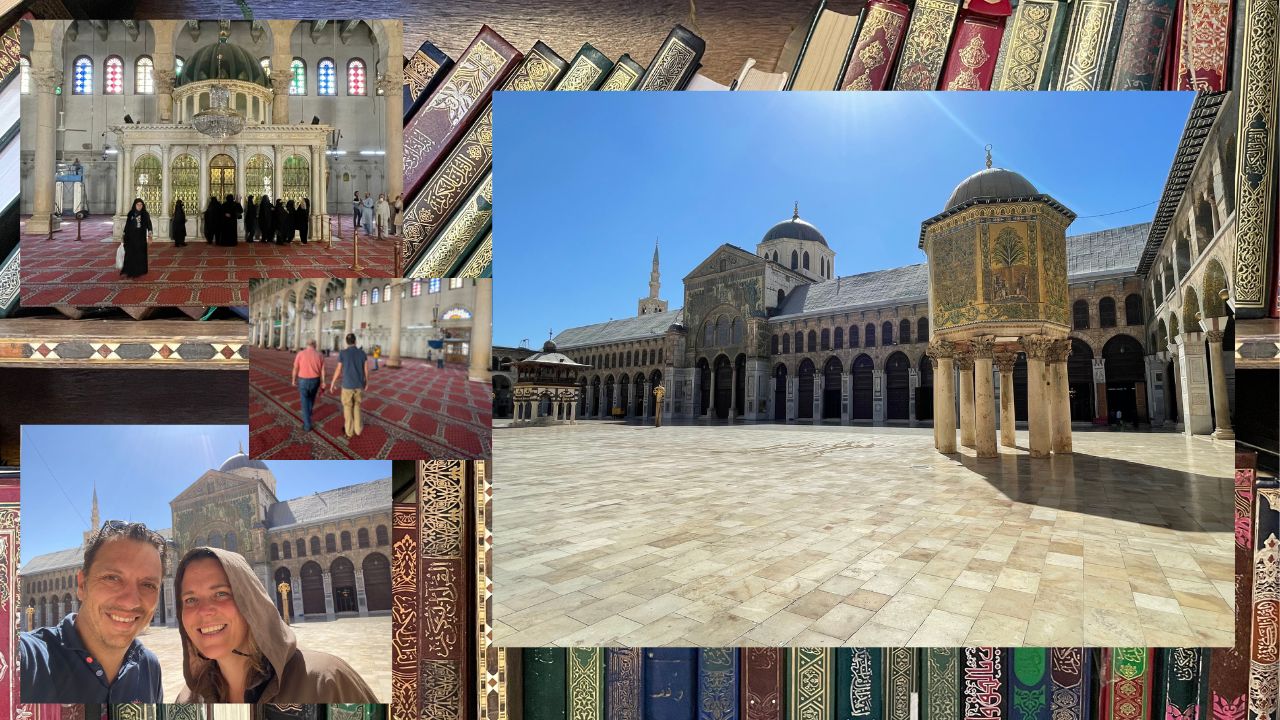
We walk through the Al-Hamidiyah Souq, the largest covered market in Syria. I know the temptation of the ice cream to resist Bakdash because of the cholera that has broken out in the country and I see all the shops selling wedding dresses and glittering furniture, passing bakers and coffee and juice sellers. At the end of the 600 meter long Souq we come face to face with the great mosque of Damascus, the Umayyad Mosque. Entering proves difficult, but once I have succeeded and I have covered myself in a long robe called an abaya or jilbab, which they provide at the entrance and have taken off my shoes, I follow my father and Roderick to the prayer room into the mosque. Of course I go into the section where only men are allowed, so I am logically requested to go to the other side of the chain, which divides the space. After seeing the altar of John the Baptist we continue our way to the courtyard, which is beautiful and almost deserted.
Al Safina

After our visit to the mosque we walked through the narrow streets of the old city. We end up at Al Safina, a L'Arche community in which people with and without intellectual disabilities live together. Al Safina appears to have been founded by my uncle in 1995, something we did not know at all.
The center consists of a house where people live who no longer have parents or guardians and another building with different rooms where workshops are given. We are received with much love and shown around. Everyone can show us what they like best to do and make in the workshops. From making paper to Christmas decorations and from key rings to eyeglass cords. They make it all and they show it all with great enthusiasm. Naturally, the necessary photos are taken of our visit and we take home the creations that we can put in our hand luggage. Both locations have a beautiful courtyard and in the house we drink the homemade liqueur from the oranges from the garden, coffee or tea and we hear more about this project. It is really impressive what Frans has put down here together with these people.
After we have left Al Safina we walk past a shop with inlaid boxes. Boxes that Uncle Frans always brought for us. I look curiously inside and then the owner turns out to be a friend of Mourad. We're invited to come in and we're allowed to pick something up. We can also visit the workshop where they are made. It is wonderful to see how these boxes, but also furniture are made. Then we visit Saint Ananias house, one of the first Christians, and the chapel of Saint Paul to be picked up by Mourad's brother-in-law to go back to the house of the Jesuits where we have lunch.
Jaramana Centre
After lunch we departed for Jaramana where the Jesuit Refugee Service (JRS) opened the Jaramana Center in 2015. This center guides young people and families through activities, meetings and workshops with the aim of forging new relationships of peaceful coexistence between people of different beliefs, cultures and traditions, and to support people's capacities and invest their ideas in the community. We are amazed, because this center is very modern and equipped with all possibilities and conveniences. They are also completely self-sufficient with solar panels and heat pumps, so young people who cannot study at home or are looking for distraction are always welcome here. My enduring heart makes a leap of happiness, because we can take an example from this.
Maaloula

Not far from Jaramana we drive through an area that has been completely destroyed by the war. I know the images from television, but up close it makes even more impact. Many neighborhoods have been completely destroyed and look like ghost towns. The skeletons of buildings stretch for miles. It's an impressive sight. It is hard to imagine what this must be like for the people who had to leave everything behind and lost everything. Every now and then you see a sign of life through a curtain fluttering in the wind or a car parked in front of the door, which betrays that a few people live here again. We can't stop anywhere here, so drive on to our next destination, Maaloula. Maaloula is a mountain village where Aramaic is still spoken. We visit the Monastery of Mar Sarkis and the Mar Taqla Monastery, a gorge between the rocks. Here too, the traces left by the war in 2013 during the 'Battle of Maaloula' are clearly visible.
Deir Mar Moussa
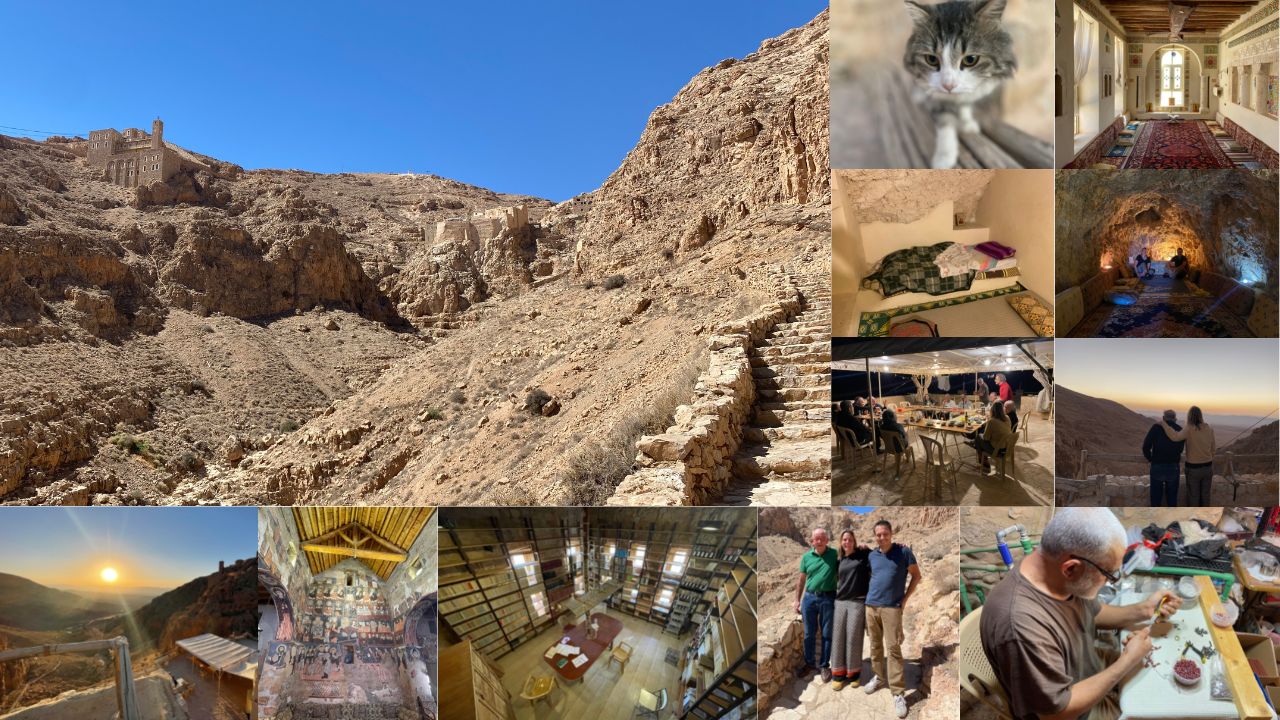
We sleep in Deir Mar Moussa, a monastery hidden in the mountains and which Uncle Frans often visited to meditate, pray and help people. In the dark we arrived at the bottom of the monastery. The day was a bit much for my father and with a new knee and heart problems he was taken to another point by Jesuit Jihad so that he only had to descend to the monastery. Roderick and I, Mourad and Denver, a woman from Italy who helped Father Jihad with his thesis, climbed up to the monastery and then picked up my father at the top of the mountain. After a warm welcome we were allowed to attend the evening service in the church with its beautiful ancient frescoes. Roderick and I were allowed to offer the sacrifice, which I experienced as very special. After the service we had dinner with all guests and residents, including Dynasty or Didi, the monastic cat. Women and men also sleep separately here.
Day 3: Deir Mar Moussa, Al Ard en Homs
The next morning we got up at 06:00 to watch the sunrise from the terrace. It really is a beautiful sight looking out over the valley. After coffee or tea we say goodbye to a number of guests, because they are going on an excursion to the village where Jihad comes from, but if we succeed we will see them tonight in Homs. This is followed by morning prayers with a tour of the church. After breakfast, the tour continues through the nunnery, which is located higher on the mountain. We also visit the cave where Paolo dall'Oglio, an Italian priest kidnapped by Islamic rebels in July 2013 and never heard from again, realized that Deir Mar Musa was his calling. We can also take a look at the candle and rosary making and the library, which consists of a beautiful collection of books. In order not to lose any more time, we then start our descent to continue our way towards Al Ard.
Al Ard
To reach Al Ard we pass several checkpoints. At one checkpoint it is the first time that we are not allowed to drive straight through, not even with the special pass of the Jesuits that Mourad carries with him because of his position and with which he only has to wave and can often drive straight on. Only Mourad now asks for the candy tin we brought with us and our passports. When he has parked the car, he gets out and walks away. There we are, but we have full confidence in Mourad so watch the whole scene around the checkpoint calmly. When UN cars drive by, we wave a friendly wave to them. Only later do I realize that it probably doesn't happen very often that western people are sitting in a normal car here, so it may have been a special experience for them too. When Mourad is back, we continue to Al Ard, which is not far away.
It is only when we drive onto the site that I realize how big it is. I've looked at Google Earth before, but it's really huge. Mourad says that they were able to build the fence that we drive through with part of the donations from Walk for Homs. This fence had to be built because too many people and animals used the products that are grown on the land. Which in itself is not bad, but because of the destruction that is also caused, we lose too much time and money with repair work. That the fence is now in place makes me feel proud, because we can now see with our own eyes what happens to the money and that together we really make a difference.
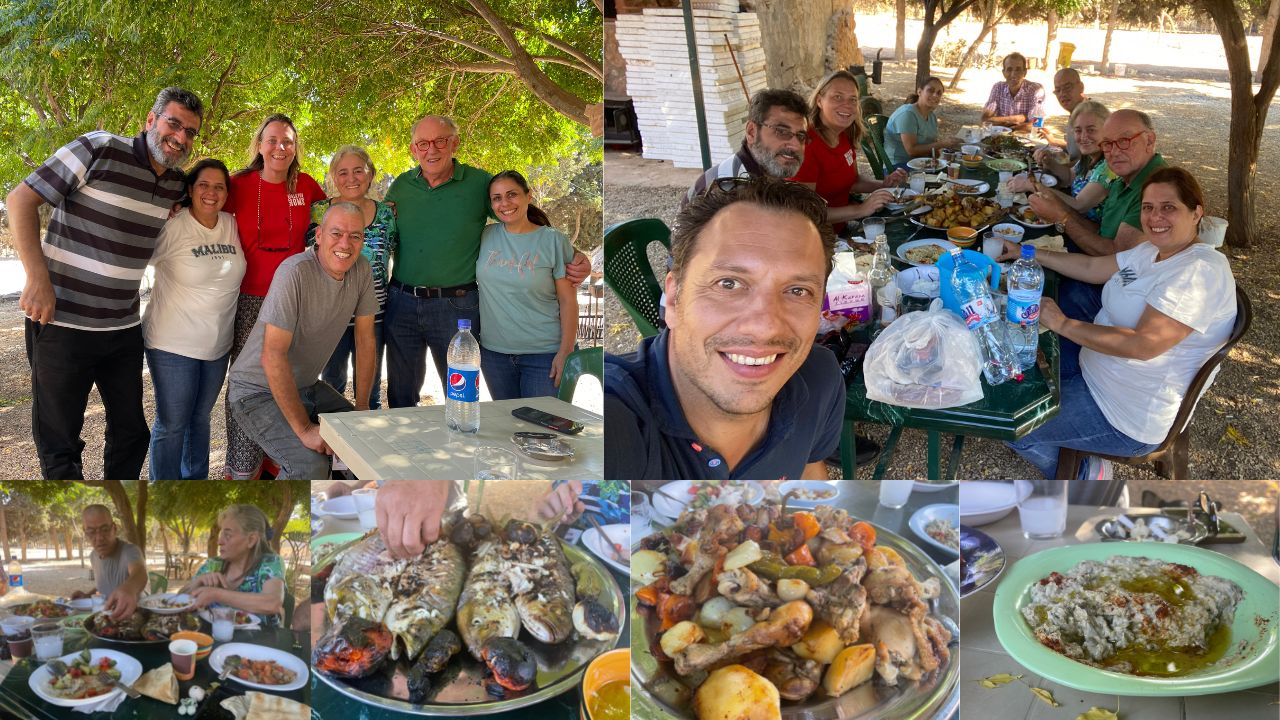
When Mourad parks the car we are welcomed with tears by Claude and her sister Caroline and Crusette with her husband Reyan. They have been working at Al Ard for years. I give them clothes from Walk for Homs and a pack of stroopwafels as a thank you for being there and supporting Al Ard. We drink coffee and tea and are then given a tour of the site by Mourad. We start at the shelter for young people with disabilities and the old motel and then the meditation rooms, the agricultural fields, the vineyards where we taste the sweet red grapes and visit the olive grove. We also look at the other reception building and the old caravans and the staff quarters. Meanwhile, Reyan takes care of the BBQ for lunch. It is a real feast with fish and meat that he has caught in the market, Baba Ganoush, oil and garlic sauce and vegetables. It's all impossible and it crosses my mind for a moment how well we have it and others don't. The three dogs also eat with us, because it is cheaper than dog food.
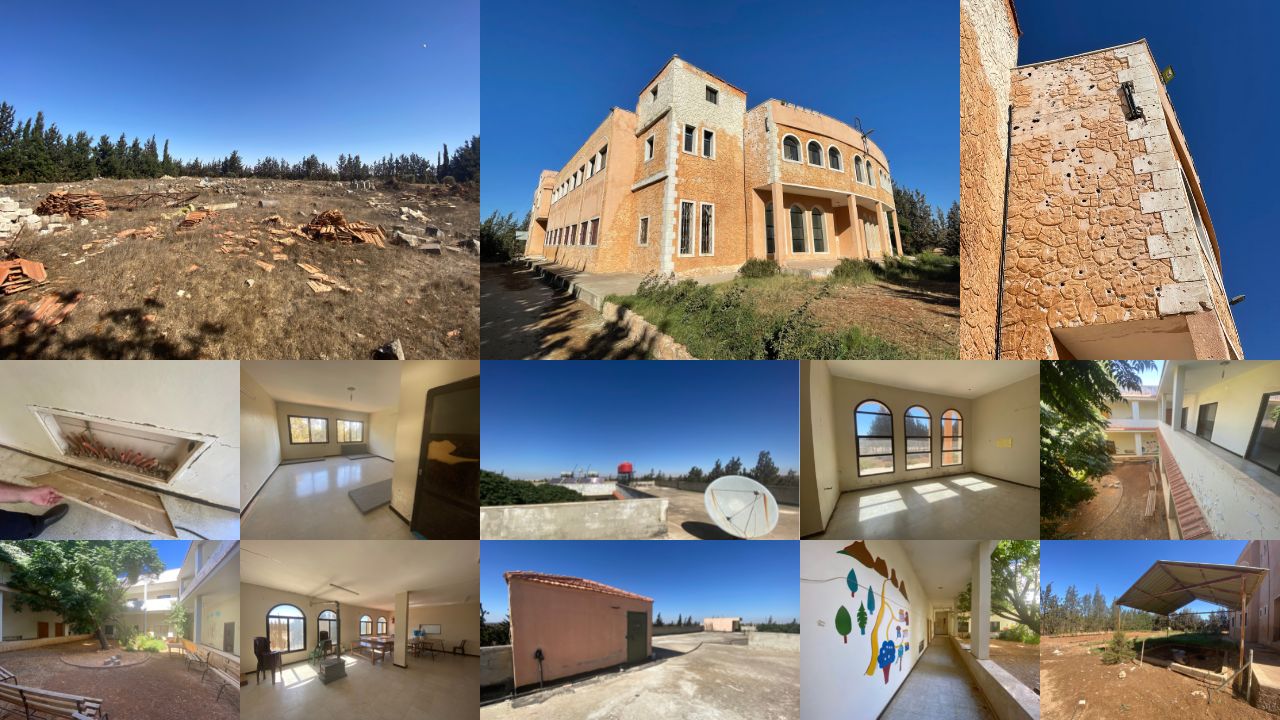
After lunch, Roderick and I go out alone to make videos of the building for the young people with disabilities, because this is the project we want to finish first with the remaining donations next to the fencing. When this is completed, they can start receiving young people with disabilities again. The windows have already been replaced and most of the bullet holes have been plugged. What still needs to be done is installing solar panels and the heat pumps have to be reconnected, so that they have their own electricity at all times and are self-sufficient. All electricity also has to be installed again, because all wiring has been stolen. In addition, the kitchen, bedrooms, dining room and classrooms must be re-insulated, plastered and painted. Finally, we will purchase all the items needed to rearrange everything, such as beds, chairs, tables, crockery and teaching materials. We also find out that the money we have raised so far will not be enough, so ask Mourad to send us a budget. In this way we will soon know what we still have to do.

When everything has been filmed, we are taken by Mourad to the wine factory. We know it was damaged during the war, but when we arrive we see that the word 'damaged' doesn't cover it. The building has been hit by heavy ammunition and is completely in ruins. The window frames have been blown away and the bullet holes are everywhere. When we enter the building we see glass, debris and wine labels everywhere. The wine barrels that are still there are pierced with bullets and the roof is riddled with bullet holes and we look right through the holes where the bombs came in. In the basement, the floor is strewn with broken wine bottles, because here the bottles were filled and provided with a cork and label. We also found a poster with which they used to advertise the wine. I can only be glad that no one was present during this attack, because we can restore buildings and buy equipment again, but we cannot return a human life.

While everyone is drinking coffee, I visit the ceramics center with Claude, which she founded with my uncle to teach women in the neighborhood to make crockery and vases to sell themselves. Like the staff quarters, the building is inspired by the Bijenkorf architecture of a farming community just south of Aleppo. It is really beautiful and Claude tells me passionately about the origin of the ceramics center and the training that my uncle Godfried gave her in Italy. Then it's time to go to Homs. Claude, Caroline, Reyan and Crusette are following us in another car, as they are coming with us.
Homs
When we arrive in Homs it is immediately apparent how badly the city was hit in the war. We drive through the streets and see images, which we also know from the news. We can clearly see that a dichotomy has taken place here. In the west of the city were the Sunni neighborhoods, which turned against the regime. They are still completely in ruins and virtually uninhabited. The Alawites, who supported the government, lived in the east and southeast of the city. Life blooms there.
When we drive into a small street I immediately recognize the monastery where my uncle lived. We park the car next to the portrait of him that is painted on the wall. As soon as we walk in I realize that this is the courtyard where my uncle is buried. I also see that there are many people present in the garden. When I see the grave I am overcome with goosebumps and notice from my father that it means a lot to him. After standing next to the grave for a while, we take a seat on a bench next to it. You can hear a coin drop in the garden, it is so quiet around us. When I look around me, the people we met at Deir Mar Musa and Al Ard are there, as are Claude, Caroline, Reyan and Crusette and some other people we haven't seen before. We place the statue that Uncle Jan gave and the copper camel, which Mourad bought for me in a shop in Maaloula, on the grave. I want to leave a treasure like my uncle who used to bring me from Syria on his grave. We buy two, because the other will be in our closet at home. In this way we are always connected. When I walk away, Mourad shows me the space underground where Uncle Frans gave his services. I also recognize this from the report that Floortje Dessing made in 2016. It is beautiful and we decide that we will also have the service here tonight.
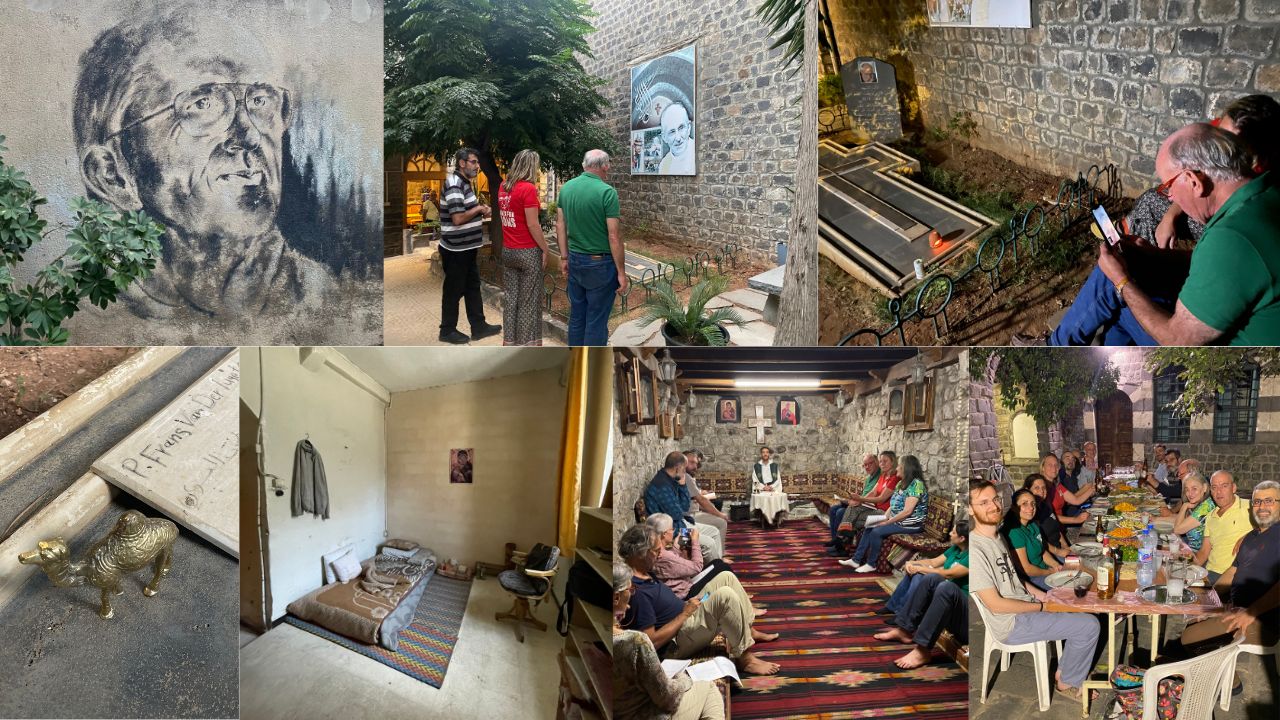
Since my father likes to call his brothers, we ask if we can get wifi. Something that is not just present here, but via a hotspot of the telephone of Jesuit Tony, the minister of the monastery, we can get in touch. When everyone has been called and has seen the grave, we can view Frans' bedroom where he slept during the war. They have left the room completely intact. Even his shoes are neatly placed in the corner of the room. Then it's time for mass. Jesuit Vincent on duty asks me if I want to read something. I'll start right away, but that's not the intention. I will get a sign. The mass is celebrated in Arabic at my father's request, because that is what Frans would have wanted. It's wonderful to be together with everyone like this again. At the end I would like to take this opportunity to thank everyone for coming and the love we receive from everyone.
Afterwards we ate together with all the inhabitants of the monastery and the people of Al Ard (Claude, Caroline, Reyan and Cruzette) in the garden next to the grave. Again, they have done an incredible job of making it a festive meal.
Day 4: Homs
This morning I woke up early so I decided to go downstairs. After sitting for a while at Uncle Frans' grave, I join Claude, Caroline, Reyan and Cruzette who are drinking coffee and tea. Reyan can't wait to show me the monastery, so we go out together with Cruzette or Claude as an interpreter. It's impressive again what I get to see. The primary and secondary school next to the monastery are still completely destroyed, but here too there are great plans to build a new center for young people. Unfortunately, official schools are not allowed to be built by the government, but a center for young people also achieves a lot. After breakfast and coffee and tea in the garden we do the tour again, because my father and Roderick have not seen this yet. Then we set off to visit two projects in Homs.
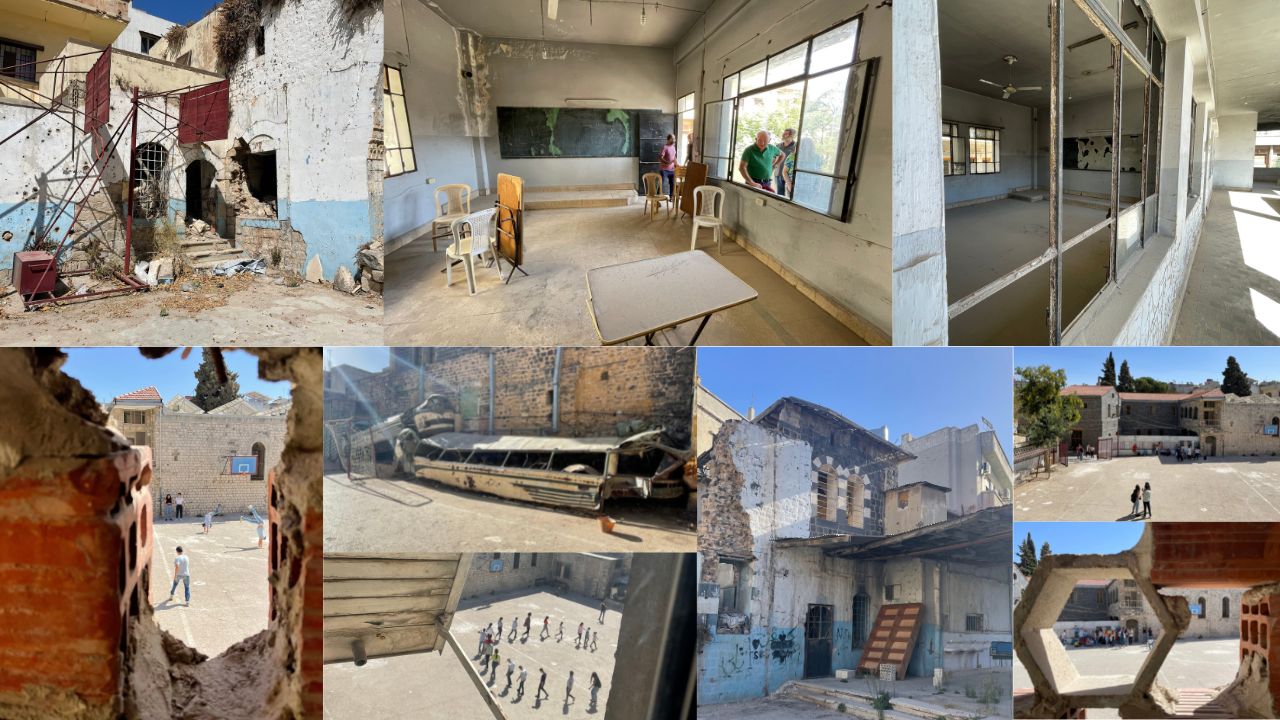
Two project visits
The first project is a shelter for young people with disabilities that was set up by a married couple with the help of the Jesuits. When we arrive there is a Syrian couple already at the door. They come here to visit because they live in Canada. Their nephew lives here and they haven't seen him in six years. After they recognize each other, a water ballet of happiness arises and the tears often roll down their cheeks.
It is a beautiful house and people work in shifts to be there for people with disabilities at any time of the day. I hand out wine gums and we are provided with coffee, tea and Syrian delicacies. Then it is time to go again to visit the Bab Sba'a school (Frans van der Lugt Centre) of the JRS. Claudette the manager flies into my father's arms with joy and proudly tells what they have already achieved here. It is a colorful whole with its own church and various rooms where workshops are given or homework can be done. Here too, children are cared for after school or because they feel the need to do so to participate in various activities. After the tour I ask Claudette if we can make a video with the children who are already there. That's okay. They all want to show me around, but we choose one of the classrooms. Everyone can tell his or her name and they teach me to count from one to ten in Arabic. I'll practice hard to remember this, I promise them. Because we don't want to interrupt the daily routine too much, Mourad tells me to go. After we have left some candy from the Netherlands for after lunch, we obediently walk behind Mourad towards the car.
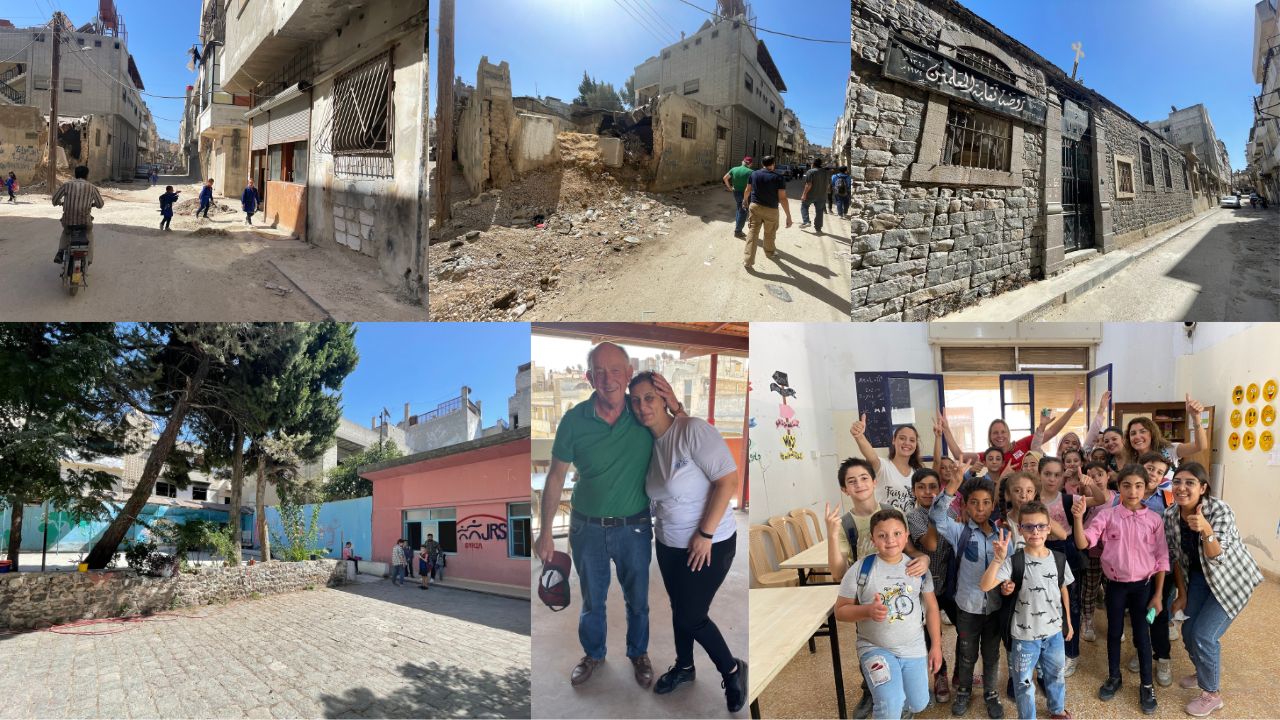
Khalid ibn Walid mosque
After lunch we visited the Khalid ibn Walid mosque. I immediately recognized the environment from YouTuber Yes Theory’s video. It gets quieter in the car as we get closer. The contrast with the completely restored mosque and the destroyed houses around it is beyond words. After our visit to the mosque we walk past the destroyed houses. We see that some people have restored their houses and as we drive further we see that people have created workplaces under the destroyed buildings. A car dealership has established itself on another street corner. A luxury car shines in the showroom and less than 100 meters away in the middle of the rubble, a street vendor has set up his stall with fruit and vegetables. To limit the heat on the products, a UNHCR tent canvas blows in the wind. It shows the enormous contrast of the country at a glance.
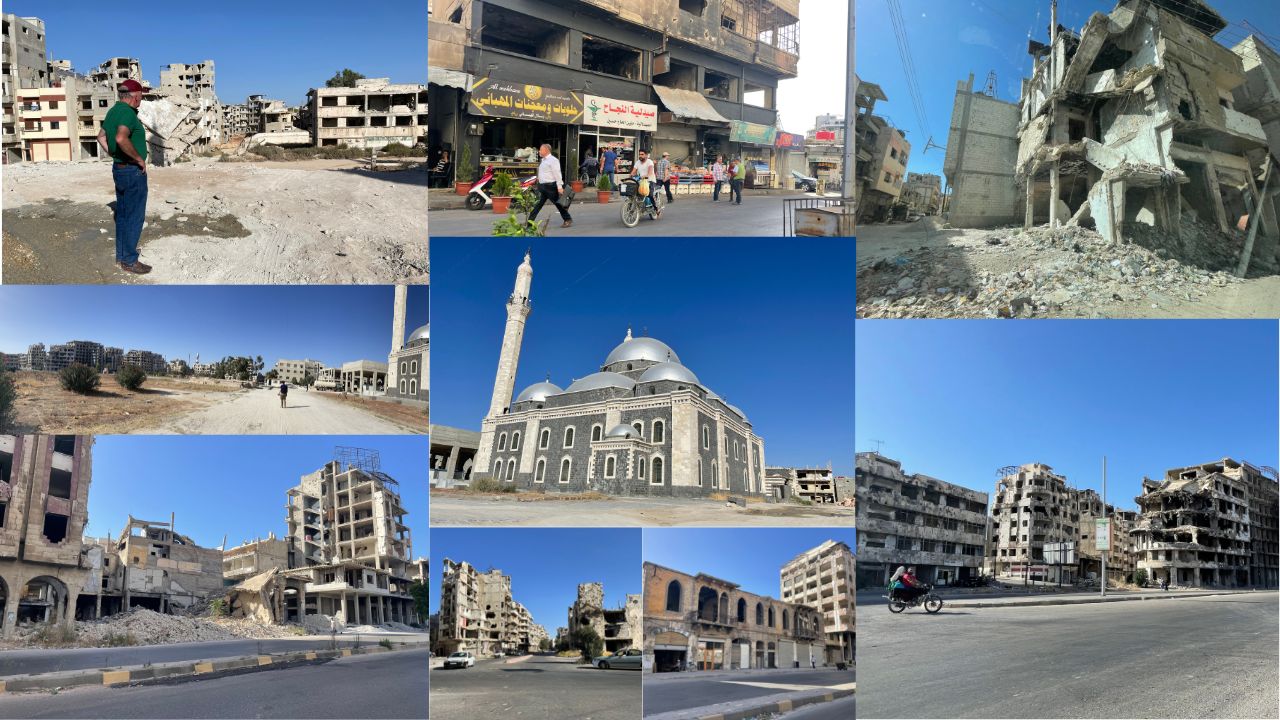
Al Moukhalles Centre
Not much later we reach the Al Moukhalles Centre that Jesuit Michael Brenninkmeijer founded. Everything has been thought of here too. Basketball and soccer fields and various spaces where young people get the help they need. My uncle's Volkswagen bus is parked in the garden as a reminder. Mourad asks me what I think they should do with it. I don't hesitate for a second and tell the young people to paint the car with the first thing that comes to mind when they think of Frans. When it is finished, it may be overgrown with plants and flowers, so that it becomes one with the earth (Al Ard). Mourad had the same idea, so hopefully I can admire the end result when I come back with Roderick.
Then a man approaches when he sees my father, tears well up in his eyes and he climbs into my father's arms. It is and remains special to see how many people know Frans and what he has meant to them. We do not hesitate for a moment to listen to them and to answer their hugs with love. It is also very nice for us to hear that my father resembles Frans so much. Not only his posture, but also his face and large ears are widely viewed and mentioned as likeness.
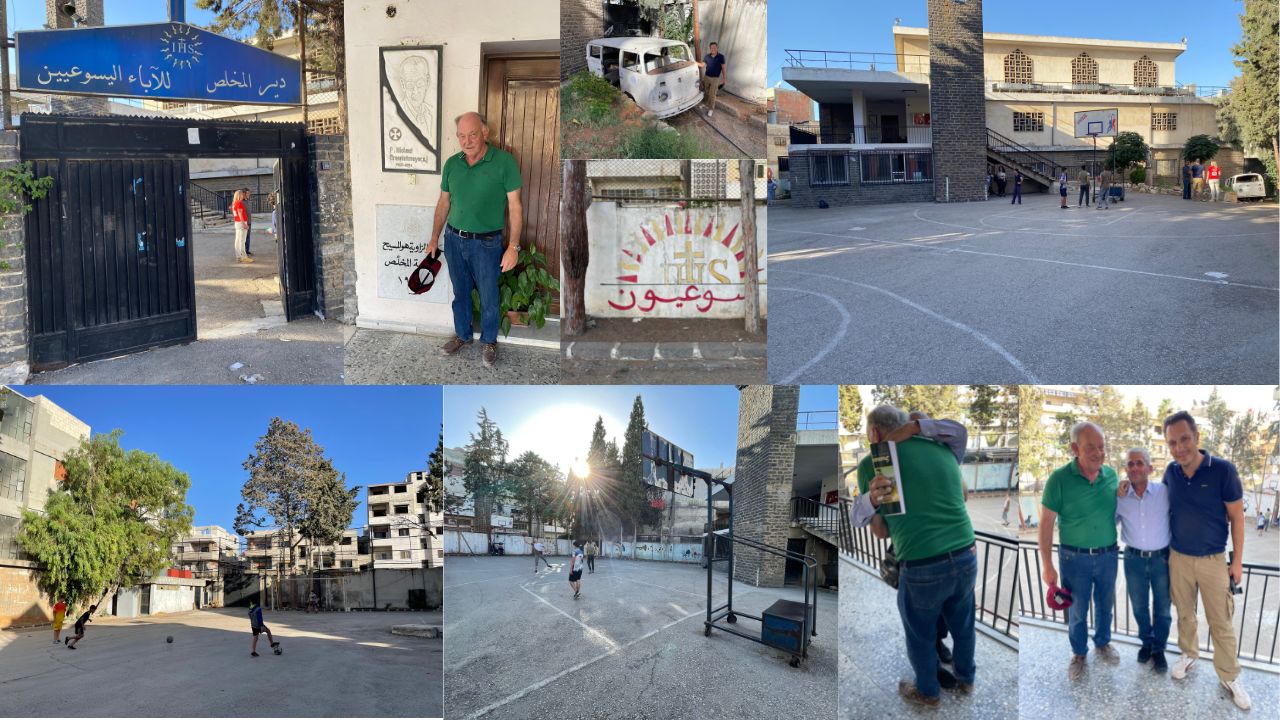
After saying goodbye, Mourad takes us to a place where a Jesuit school once stood. This school was completely destroyed during the war. The rebuilding will have to wait a few more years, so in the meantime an entrepreneur can use the site as a terrace for his restaurant. He gives part of his proceeds to the projects of the Jesuits to help people who need help in this way. Fortunately, because it feels very strange to be in a restaurant when there is so much poverty around us. Of course I realize all too well that this also helps the economy, but somehow it doesn't feel right now. So when we leave, I ask Mourad without sharing my thoughts what he thinks about this. Luckily this is the same.
We also visited the Um Al Zennar Cathedral. The church contains a venerated Holy Girdle which seems to be part of the girdle of Mary, mother of Jesus before going back to the monastery.
Syria in spring
These are quite strenuous days with many impressions, so the moment of rest that follows in the garden of the monastery is very welcome. This also gives us the opportunity to thank Mourad for this special trip. He has organized everything down to the last detail and for that we also thank him very much with a donation, which he can spend on something or someone who can now use it well. He doesn't have to think twice about it, because this afternoon he was told that a woman in the home for young people with disabilities urgently needs surgery on her leg. We think this is a very nice destination. I also indicate that in addition to Walk for Homs, me and Roderick also roll up their sleeves. During our visit to Al Ard our hands started to itch and we would love it if we could come and help for a few weeks to get Al Ard open again to receive young people with or without a disability. That is why we ask Mourad if it is possible to come again, but longer. The sparkle in his eyes speaks volumes and we agree to try to come back in the spring of 2023.
Apr 7, 2014
After dinner with Mourad, Michael and Ghassan with Frans, Spanish, English and Arabic words flying across the table, we take a seat in the garden for tea. Claudette from the Bab Sba'a school came along with her husband Nizar and Nazem to talk to us over tea. Nazem was at the scene 30 minutes after my uncle's murder and buried Frans in the garden of the monastery and would like to tell us about this. Everyone is all ears and we completely forget about the tea. It soon becomes apparent that the first reports in the press are incorrect. Uncle Frans was in the monastery with another Jesuit when a masked man stood at the door. The man said he wanted to speak Frans because he had a special message for him. Frans did not want to leave the monastery and the man was invited to come in and talk. While sitting on a chair in the garden of the monastery, Uncle Frans was shot once in the head for no reason and died. The masked man disappeared. Together with the Jesuit present, Nazem wrapped Frans in a cloth and carried him outside to go to the hospital of the rebels, in the hope that a death certificate could be drawn up. Unfortunately this was not possible and they took him back to the monastery. There he is prepared for his funeral, which it was uncertain whether this could take place somewhere in Homs or in the monastery garden. Finally, at 5 pm, the Jesuits decided to bury him in the garden where he still lies. After this impressive and emotional conversation, we warmed up the tea that had become cold in the meantime and treated everyone to stroopwafels to end the evening.

Day 5: Beirut and Bikfaya
In the morning we have breakfast at 6.30 am together with Ghassan and Mourad. At a little after 07:00 the taxi is ready and it is time to say goodbye. We leave Homs behind us and drive towards the border post of Aboudieh. With limited English and some hands and feet we exchange some words with the taxi driver and we drive past a very different landscape than we have seen so far. It is greener, more hilly and there are many tent camps where workers are housed to work on the fields. At the border we are waiting for an hour on a bridge. When I look down, the river is full of garbage. Something that we encounter a lot along the way. Sometimes you see the garbage flying through the air like a flock of birds. It is close to my heart, but it is something for which there is not yet a solution and they do not separate waste according to Mourad. In addition, setting up a waste service, as we know it, is not a priority at the moment. Although this does create employment, that again depends on the government.
Lebanon and Beirut
Once we enter Lebanon, the environment changes almost immediately. Villages and cities pass us by and there are several hotels by the sea. Just before Tripoli we stop for a while, so that the driver can stretch his legs. When we drive into the port of Beirut, the damage from the fireworks disaster at the beginning of August 2020 is immediately visible, as is the repair work. I realize all too well that you can rebuild everything, but not a lost life.
We are invited to the Jesuits in the Jesuit residence which is located near the harbor for lunch. We are picked up by Jesuit Thom, who takes us to the roof terrace to tell us more about the area and the current situation. Afterwards it is time for coffee in the common room and we meet Jesuits Paul and Frans, with whom we also have lunch together. All three of them knew Uncle Frans well, so we enjoyed hearing their stories. After lunch a taxi is waiting for us, because before we leave for the Netherlands we will visit the residence of Notre Dame de la Délivrance in Bifyaka where Uncle Frans learned Arabic.
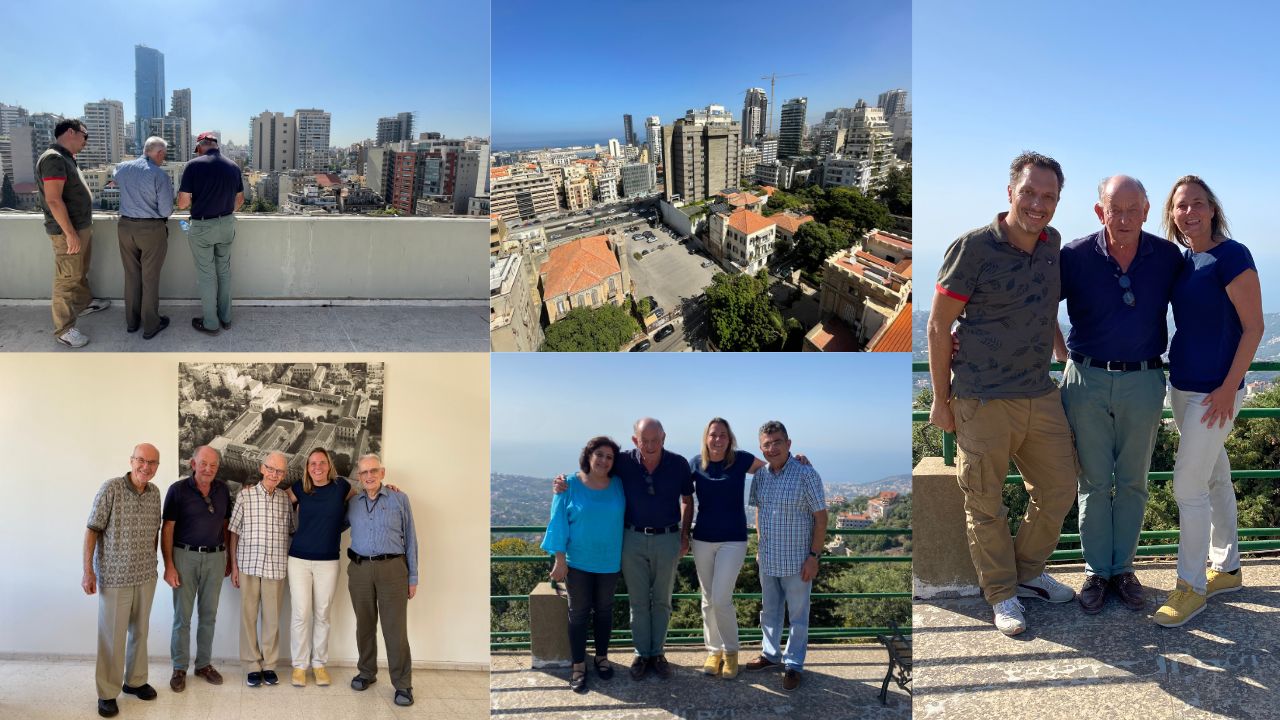
Bifyaka
We are received by Jesuit Narwas, who was my contact person for Mourad for the projects we support from the JRS and the Jesuits. We are also accompanied by a woman, her flight to Frankfurt has been canceled, but this too has a reason. She knew Frans well and proudly showed the pictures of Frans with her children. After tea and acquaintance, we get a tour of the residence with a beautiful view of the valley and admire the church and the portrait of Frans that we encounter in the hallway. When it is 4 pm we leave again, because it is time to go to the airport. We will not say goodbye to Syria, but say araki qariban (see you soon), because Roderick and I will be back in the spring to roll up our sleeves on Al Ard, but also because I understand very well that Uncle Frans wanted to stay for his people in his country…















